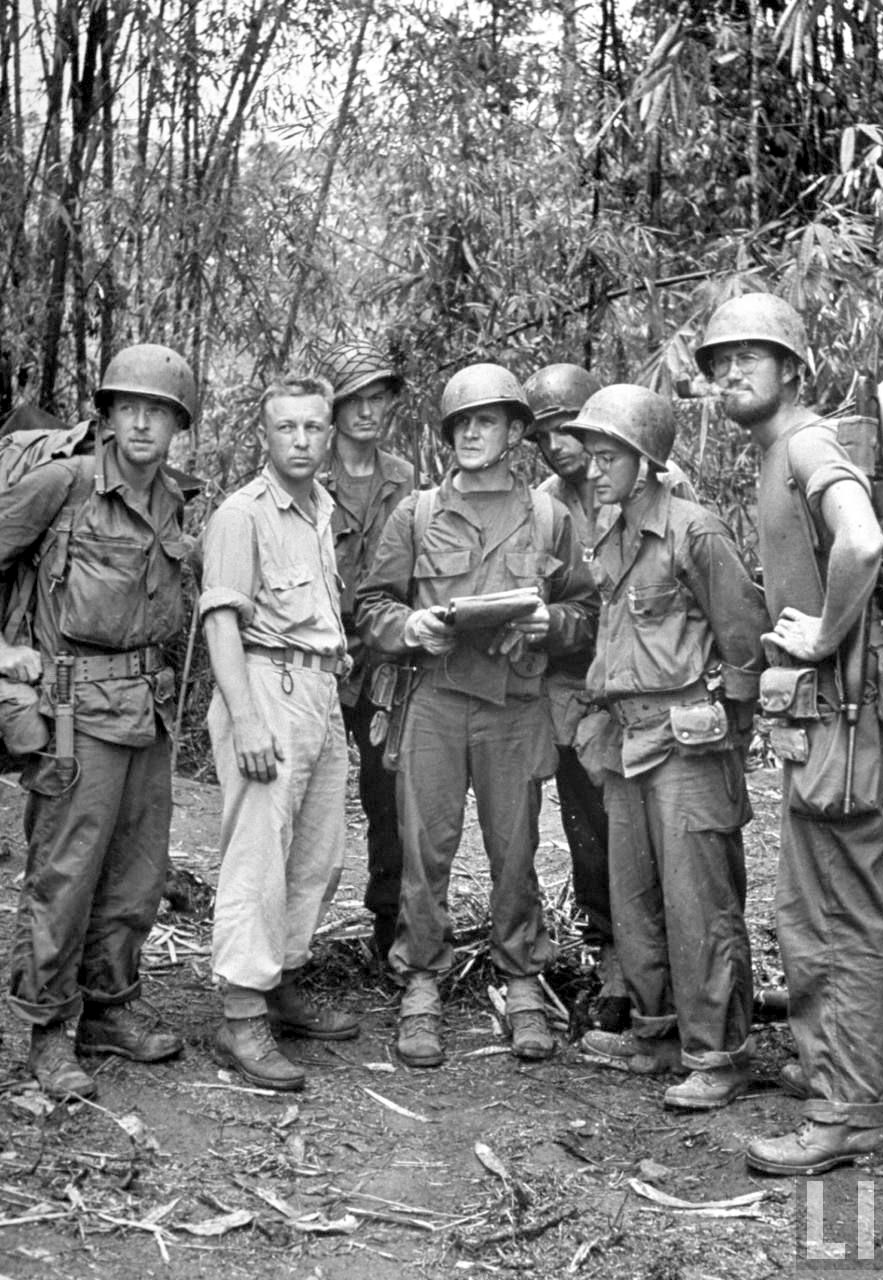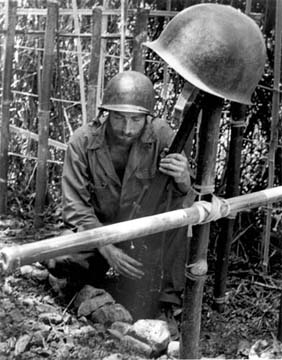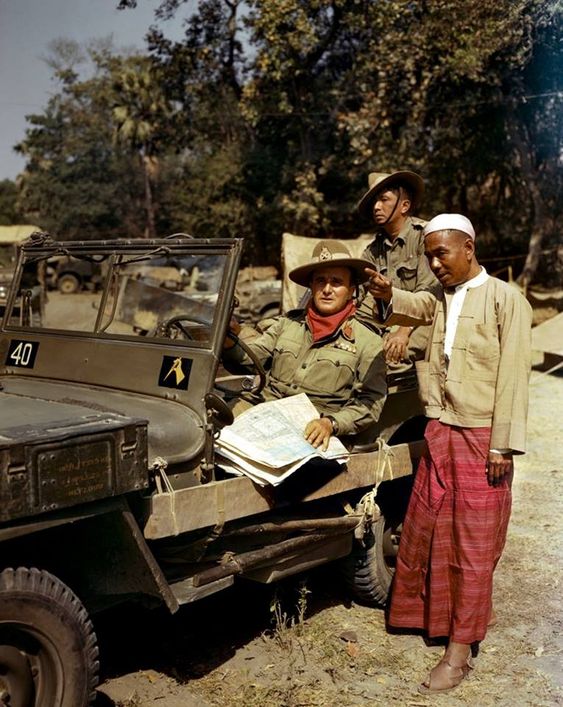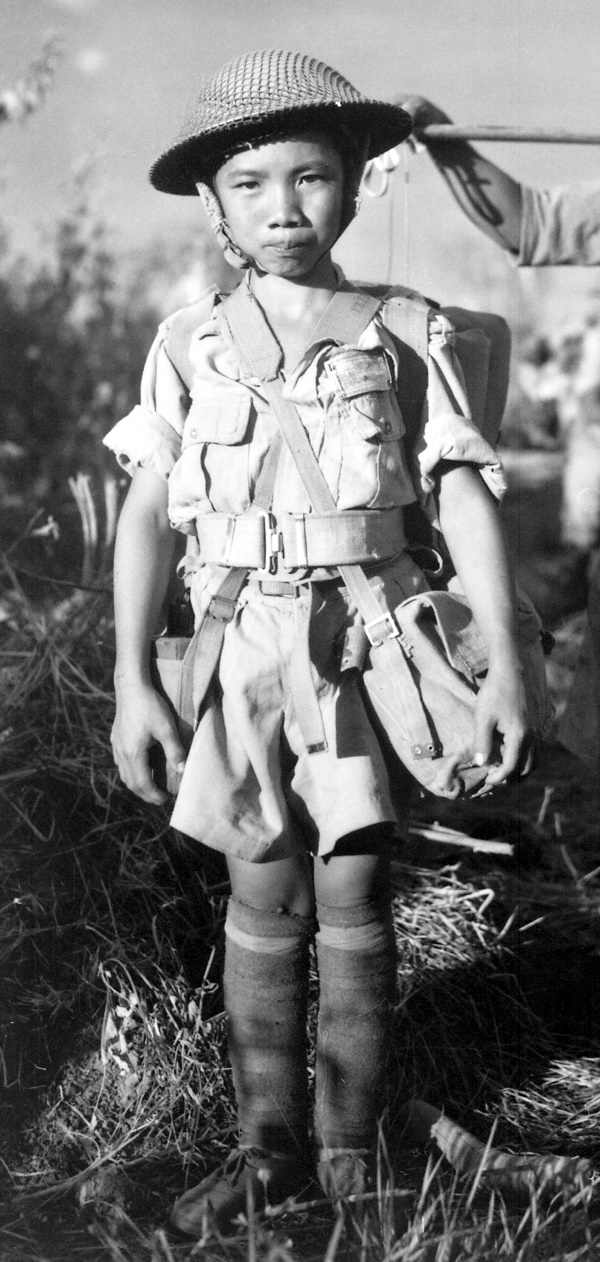During this time, Hunter apparently did not object to sending the 5307 on this mission. In his memoirs, he only notes that he asked for one week’s rest before leaving Hsamshingyang. Merrill, too, did not object to the mission. Perhaps both, he and Hunter, believed taking Myitkyina justified additional sacrifice on the part of the 5307. Maybe they felt that objections were futile because of Stilwell’s views that willpower could overcome some of the debilitating effects of tropical diseases, and that soft-hearted medical officers were probably contributing to the high evacuation rate for illness in the 5307. In any case, when Stilwell told Merrill that he knew he was asking Galahad for more effort than could fairly be expected of it and that he had no other option but to do so, he left Merrill with no basis to oppose the operation.
Stilwell had no choice but to use the 5307 to execute End Run because the nature of the forces he commanded made it necessary for Americans to lead the Myitkyina task force. The Chinese were not trained for long-distance cross-country maneuvers through the jungle. They also lacked the aggressiveness for such an undertaking. Moreover, any attempt by Stilwell to send a Chinese force alone against Myitkyina would certainly have been opposed by Chiang Kai-Shek as being too risky. Another problem was that a Chinese force would have required Kachin guides, but the Kachins did not like the Chinese.
Slim notes that in the retreat from Burma in April-May 1942, the Chinese troops fleeing north through the Mogaung and Hukawng Valleys had looted villages with no law and little mercy. As a result, in Ogburn’s words, the Kachins disliked and feared the Chinese at least as much as the Japanese. To ensure full, effective participation by the Chinese and the Kachins, the force moving on Myitkyina had to be a combined force under American command.
On Apr 17, two days after the 50th Chinese Division had completed its move from Yunnan to Maingkwan, Stilwell met with his staff and Merrill to discuss the plan. On Apr 21, Stilwell set up the task force to seize Myitkyina. Because the 5307 had lost approximately 50% of its strength and was down to about 1400 men, it needed to be augmented by Chinese and Kachin soldiers. Three combat teams commanded by Americans were created, and Merrill was given over a command.
H Force, under Hunter, contained Galahad’s 1/5307, the 150th Regiment of the 50th Division, the 3rd Company of the Animal Transport Regiment, and a battery of 22nd Division artillery. K Force, under Col Kinnison, contained Galahad’s 3/5307 and the 88th Regiment of the 30th Division.
M Force, under Col McGee (CO 2/5307), contained Galahad’s 2/5307 and 300 Kachins. On Apr 22, two days short of the full week of rest that Hunter had requested, the 5307 left Hsamshingyang and began the twenty-mile march north to Naubum. There, the battalions set about organizing the combat teams and preparing for the operation. On Apr 28, K Force moved out. H Force followed two days later. On May 7, M Force started on its way. Despite their illnesses and fatigue, the soldiers of the 5307 set out for Myitkyina in fairly high spirits. When they had first heard of this mission, they had been filled with disbelief and resentment. They had felt that Stilwell’s headquarters was either ignorant of the shape the unit was in or indifferent to it or out of its mind. However, their outlook improved after they were promised that, after capturing the Myitkyina airstrip, they would be relieved and flown to a rest and recreation area.
As Ogburn states, we had it from Gen Merrill himself that we would be a party to cause taxpayers a shudder and given furloughs. This vision gave them the will to see this new mission through. The hard reality of the march, the rain, the mud, the steep narrow trails where exhausted animals slipped and fell down mountainsides carrying their precious loads with them, the effects of disease and malnutrition, and the attacks of insects and leeches – all of these things soon began to sap the soldiers will. The conditions were far more difficult than any of them had encountered previously, and many soldiers had to be evacuated because they were too sick and weak to continue. At some points, groups of men were left behind with the promise that help would be sent.
Yet most of the troops did manage to keep moving forward, and on May 17, H Force attacked and captured the main Myitkyina airfield. The men of the 5307 thought that this victory meant they would be released from their hardship, but despite the earlier promises, it was not to be. Again, tactical necessity and the nature of combined operations made it impossible to relieve them. Instead of being flown out, they were committed to a positional battle against a growing Japanese force that was vigorously defending the town of Myitkyina and threatening to recapture the airfield.
As explained by Boatner later, Stilwell felt that he had to keep Galahad at Myitkyina for four reasons, (1) Galahad was the only US combat unit in the theater available for the assault on Myitkyina; (2) The Chinese 88th and 150th Regiments that marched over the Kumon Range with Galahad had felt evacuations for sickness – fatigue in spite of their heavy casualties; (3) Since early May Stilwell had been resisting heavy pressure to evacuate the 3rd Indian Division, the Lentaigne’s LRPG Chindit force. (4) The Japanese lines were only 1500 yards from the airstrip which was the only base and source of supply.
Reason number four expresses Stilwell’s tactical need to keep the 5307 at Myitkyina and reflects the simple requirement to have sufficient soldiers in Myitkyina to handle the Japanese. This was a growing requirement as Japanese strength increased. After May 21, Stilwell was even forced to pull two battalions of Army engineers off the Ledo Road construction work and rush them to Myitkyina as reinforcements. In addition, a directive was issued to hold the number of sick and fatigued soldiers being evacuated down to an absolute minimum. Second, staff officers in the rear were ordered to comb their areas for earlier Galahad evacuees and send as many as possible back to the unit. At this time, there was no possibility of relieving Galahad. The situation demanded that the unit stays in the fight. Coalition warfare and the nature of combined operations were also making relief of the 5307 out of the question. Galahad was the only US combat unit in the theater. This gave it a symbolic significance beyond the combat power that its soldiers could generate. Stilwell wanted the Chinese to continue fighting, and he wanted the units of the Indian 3rd Division (Chindits) that were withdrawing northward toward Mogaung and Myitkyina to hold their ground. To achieve these goals, he needed the presence of the 5307 on the battle line.
Facing a classic problem inherent in combined operations, Stilwell was determined not to let the impression be created that he was withholding US troops from combat in a sector where as an Allied commander he was keeping British and Chinese troops in combat. Keeping the 5307 in Myitkyina was, therefore, Stilwell’s way of addressing a fundamental problem of combined operations – maintaining teamwork and trust and keeping all forces united in their efforts.
The 1993 edition of FM 100-5, Operations, states clearly that, in combined operations, missions should be perceived as appropriate and achievable for the forces to which they are given and equitable in terms of burden and risk-sharing. The key phrase here is equitable in terms of burden and risk-sharing, for, in combined operations, the surest way to create discord is to create the impression that the units of one nation are being favored in some way over the units of another. When units of one nation are under the command of an officer from a different country, the danger of such impressions being formed is especially high. This is why FM 100-5, Operations, states that national contingents normally retain command of their own forces. Stilwell, an American, was commander of the Chinese Army in India, and since May 17, the Chindits had also been attached to his command. As the combined force commander, he certainly did not want to be seen as playing favorites with the 5307.
Stilwell’s situation was already delicate because of high Chinese casualties and a feeling among the Chinese that their tasks were more difficult than those assigned to Galahad. Gen Zheng Dongguo, who had been sent to India to command the CAI in the field of Stilwell did not feel that the Chinese were being given the hardest and most dangerous missions and that the Americans were looking for something that could be taken easily. Then, when the Americans got in trouble, as they did at Walawbum, they would call on the Chinese for help. He, June, the deputy division commander and chief of staff of the 38th Division, had the same complaint.
Certainly, in terms of combat casualties, the Chinese were paying a heavier price than the Americans. By Apr 15, Chinese casualties in north Burma were as follows, for the 22nd Division, 800 men were killed and 2000 were wounded. For the 38th Division, 658 men were killed and 1450 were wounded. Reflecting the heavy fighting around Myitkyina, the 150th Regiment of the 50th Division by May 20 had taken 671 battle casualties.
Boatner was well aware of Chinese concerns and felt embarrassed in his dealings with the Chinese because of the 5307’s withdrawals from its roadblocks. Under these circumstances, withdrawing the 5307 from Myitkyina and sending it back to India would undoubtedly have harmed the combined force’s sense of unity.
 Chinese attitudes were also a concern for Stilwell as he dealt with Lentaigne’s requests to allow the Chindits to withdraw quickly to the north. The Chindits were wearing out just like the 5307 was, and Lentaigne felt that they were no longer fit for service. But Stilwell worried about what would happen to Chinese morale if troops who had only entered combat in March passed through their lines on the way to India.
Chinese attitudes were also a concern for Stilwell as he dealt with Lentaigne’s requests to allow the Chindits to withdraw quickly to the north. The Chindits were wearing out just like the 5307 was, and Lentaigne felt that they were no longer fit for service. But Stilwell worried about what would happen to Chinese morale if troops who had only entered combat in March passed through their lines on the way to India.
Also, following close behind the Chindits were the Japanese moving northward. If the Chindits did not hold their blocking positions south of Mogaung, these Japanese units would move north to fight against the 38th and 22d Divisions in the Mogaung Valley and reinforce the Japanese at Myitkyina. Thus, Stilwell refused Lentaigne’s request and ordered him to hold the Japanese well south of Mogaung. Stilwell’s answer to statements about the greatly weakened physical condition of the Chindits was to respond that the 5307 had been through as much, if not more, and was still in the field.
This, then, was Stilwell’s solution to the problem of equitable burden-sharing. Every nation’s units were to suffer equally. Looking at the 5307’s experience from this perspective, it can be realized that the unit was not sacrificed, as Col Hunter charged, to satisfy Stilwell’s ego. It just happened that it was the only American combat unit available, and the combined force that Stilwell commanded needed American participation. Stilwell had, as he told Gen Merrill, no choice but to ask Galahad for more than could normally be expected of it. Without Galahad to help hold up the coalition banner of shared suffering, the combined force would have lacked a crucial unifying element and a catalyst for action.
Fatigue, disease, undernourishment, and the stress of battle continued to weaken Stilwell’s soldiers. Added to this was the feeling by the members of the unit that they had been lied to and abused – an impression that spread through the unit after the men learned that they were going to be kept at Myitkyina. Morale fell precipitately and, with it, the men’s physical well-being. Shortly after Galahad had reached Myitkyina, the regimental and battalion surgeons had recommended that the entire unit be withdrawn because of its wretched physical condition. For the reasons discussed above, this advice was not heeded. The directive to hold down medical evacuations and efforts to beat down fevers with medication led to no improvement.
 During the last two weeks of May, evacuations due to illness ran about 75-100 per day, with a peak day of 134. Steadily, the unit faded away. By May 30, the 2/5307, which had started off for Myitkyina with 27 officers and 537 men, had only 12 men left in action. The situation in the 3/5307 was about the same. Only the 1/5307 still had some strength – a handful of officers and 200 men. In his diary for this day, Stilwell was forced to write, Galahad is just shot.
During the last two weeks of May, evacuations due to illness ran about 75-100 per day, with a peak day of 134. Steadily, the unit faded away. By May 30, the 2/5307, which had started off for Myitkyina with 27 officers and 537 men, had only 12 men left in action. The situation in the 3/5307 was about the same. Only the 1/5307 still had some strength – a handful of officers and 200 men. In his diary for this day, Stilwell was forced to write, Galahad is just shot.
 At this time, the 5307 truly was nonoperational, but it was to continue in existence for two more months. On May 25, 2500 Galahad replacements landed in Bombay, India, and were rushed to Myitkyina as quickly as possible. In early June, these soldiers and the remnants of the 5307 were organized into one old Galahad battalion and two new Galahad battalions. With the two engineer battalions that on June 8 were grouped into a provisional regiment, they maintained the American presence in what was now the siege of Myitkyina.
At this time, the 5307 truly was nonoperational, but it was to continue in existence for two more months. On May 25, 2500 Galahad replacements landed in Bombay, India, and were rushed to Myitkyina as quickly as possible. In early June, these soldiers and the remnants of the 5307 were organized into one old Galahad battalion and two new Galahad battalions. With the two engineer battalions that on June 8 were grouped into a provisional regiment, they maintained the American presence in what was now the siege of Myitkyina.
But the new Galahad was not the old Galahad and never really could be. That force had experienced something special and accomplished something extraordinary. It was fitting, therefore, that after Myitkyina fell, the 5307 was disbanded. The fate of the organization thus mirrored what had happened to virtually all of the men who had served with it. In the campaign to reach and take the strategic objective of Myitkyina, they had reached the limit of what they could do and could do no more.
There is much to be gained by examining the experiences of the 5307. The soldiers established an inspirational standard of endurance and courage in the face of an extremely harsh natural environment and a dedicated foe. The unit’s long cross-country movements illustrate the innovative use of the new capabilities given military forces at the time by advances in communications technology and aerial resupply techniques. But no lessons to be learned are greater than those related to the conduct of combined or multinational operations.
If, as Col Hunter asserts, Galahad Force was the most beat upon a regimental-sized unit that participated in World War Two the reason for this happening is to be found most of all in the combined nature of the northern Burma campaign. As the only American combat unit within the combined force, Galahad could not avoid being given the special burdens that came from being Americans. Their presence was required to form viable multinational task forces when the units of other countries could not or would not work together alone. Their participation in operations was necessary to encourage the units of other nations to stay in the struggle and to fight hard. The 5307 was the means by which the American field commander, Gen Stilwell, showed that he was not asking more of his coalition partners than he was asking of American soldiers. What was especially damaging to the 5307 was that it was a small unit and the only US combat unit under Stilwell’s command. It had to bear America’s fighting burden alone. Eventually, and perhaps inevitably, it collapsed under the weight of its combined load.




















